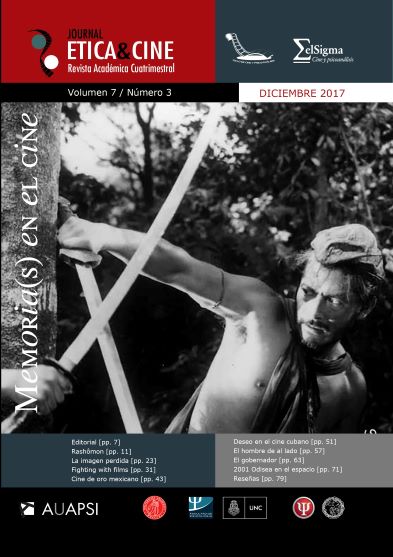Book review: The wonderful eye. (Des) meetings between psychoanalysis and cinema
DOI:
https://doi.org/10.31056/2250.5415.v7.n3.19628Keywords:
The wonderful eye (Des) meetings between psychoanalysis and cinemaAbstract
Is psychoanalysis filmable? Before the proliferation of films and series that seek to recreate on the screen the figure of analysts and patients, the question becomes inescapable. To address this delicate issue, both clinical and aesthetic, the most anticipated book has just appeared: The wonderful eye: (des) encounters between psychoanalysis and cinema. The result of a rigorous investigation of decades, Eduardo Laso's work comes to crown his solid training in psychoanalysis, epistemology and ethics, along with his passion for cinema. Professor for many years of the chair of Irene Friedenthal (Psychoanalysis: Freud) and founding member of the Buenos Aires Society of Psychoanalysis, he is currently a researcher of the UBA Science and Technology Program and professor of Ethics and Human Rights and Psychology at the CBC . To give a semblance of only one of the points developed in the book, let's say that Sigmund Freud, the inventor of psychoanalysis, was recreated on the screen in more than twenty films. Incarnated by actors such as Montgomery Clift, Curt Jurgens, Max von Sydow or Viggo Mortensen, his figure became an icon of culture. The cinema represented Freud analyzing his classic patients, such as Anna O., Elizabeth von R, or Dora, but also Gustav Mahler, Marie Bonaparte or Lou Andreas-Salomé. And by the way to apocryphal characters, such as young Indiana Jones, Sherlock Holmes, Hitler, Mr. Spock, or the Transylvanian vampire himself. This long series, ranging from sublime representations to ridiculous banalizations, informs us about the revulsive nature of psychoanalysis. His viewing and careful reading by Eduardo Laso allows us to think about the tension between ethics and aesthetics, while introducing epistemological issues from a renewed experience as spectators in a movie theater.
Downloads
Published
Issue
Section
License
Los autores que publiquen en Ética y Cine Journal aceptan las siguientes condiciones:
Los autores/as conservan los derechos de autor © y permiten la publicación a Ética y Cine Journal, bajo licencia CC BY-SA / Reconocimiento - Reconocimiento-CompartirIgual 4.0 Internacional. La adopción de esta licencia permite copiar, redistribuir, comunicar públicamente la obra, reconociendo los créditos de la misma, y construir sobre el material publicado, debiendo otorgar el crédito apropiado a través de un enlace a la licencia e indicando si se realizaron cambios.

Este obra está bajo una licencia de Creative Commons Reconocimiento-CompartirIgual 4.0 Internacional.




